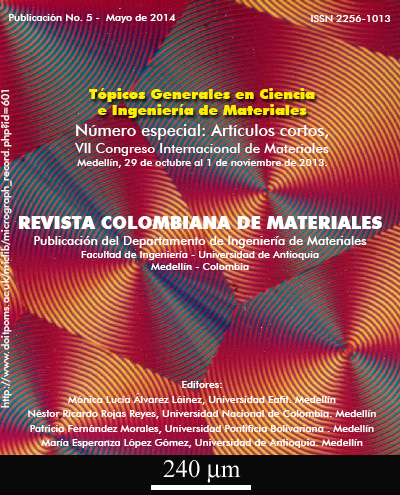.
DOI:
https://doi.org/10.17533/udea.rcm.19419Keywords:
Geometric parameters, Joint thickness, Overlap length, surface roughness, experimental designAbstract
Downloads
References
García, G., Toro, A., Martínez, M. “Diseño de un ensayo de torsión para uniones adhesivas anaeróbicas”. En: VIII Jornadas de Adhesivos, España, Septiembre 26 –28 de 2007.
P. Davies. Influence of adhesive bond line thickness on joint strength, Elsevier, 724 –736, 2009. DOI: https://doi.org/10.1016/j.ijadhadh.2009.03.002
Kinloch AJ, Moore DR, The influence of adhesive bond line thickness on the toughness of adhesive joints, in The application of fracture mechanics to polymers, adhesives and composites, ed Moore DR, Elsevier 2149-155, 2004.
Kinloch AJ, Adhesion and Adhesives, Science and Technology, Chapman and Hall, 1987. DOI: https://doi.org/10.1007/978-94-015-7764-9
J.W. Kwon, D.G. Lee, The effects of surface roughness and bond thickness on the fatigue life of adhesively bonded tubular single lap joints, J. Adhesion Sci. Technol.14, 1085 –1102, 2000. DOI: https://doi.org/10.1163/156856100743095
Tezcan S. “The effects of surface roughness on the strength of adhesively bonded cylindrical”,J. Materials Processing Technology. 142, 82–86, 2003. DOI: https://doi.org/10.1016/S0924-0136(03)00463-1
García G. Influencia del acabado superficial sobre la resistencia de juntas adhesivas para fijación de elementos cilíndricos. Tesis Maestría, Universidad Nacional, Medellín 2006.
Jose M. Arenas, Julian J.Narbon, Cristina Alıa. Optimum adhesive thickness in structural adhesives joints using statistical techniques based on Weibull distribution. International journal of adhesion 30. 160-165, 2010 DOI: https://doi.org/10.1016/j.ijadhadh.2009.12.003
Montgomery, Douglas C. Design and Analysis of Experiments. United States of America John Wiley & Sons, Inc, 2004.
Hosseinzadeh, Ramin. Taheri, Farid. Non-linear investigation of overlap length effect on torsional capacity of tubular adhesively bonded joints. Composite Structures 91, 186–195, 2009. DOI: https://doi.org/10.1016/j.compstruct.2009.04.047








